+ Open data
Open data
- Basic information
Basic information
| Entry | Database: PDB / ID: 3kse | ||||||
|---|---|---|---|---|---|---|---|
| Title | Unreduced cathepsin L in complex with stefin A | ||||||
 Components Components |
| ||||||
 Keywords Keywords | Hydrolase/Hydrolase inhibitor / cathepsin / protease-inhibitor complex / stefin / cystatin / papain-like / cysteine protease / Hydrolase / Lysosome / Protease / Thiol protease / Zymogen / Thiol protease inhibitor / Hydrolase-Hydrolase inhibitor complex | ||||||
| Function / homology |  Function and homology information Function and homology informationenkephalin processing / cathepsin L / CD4-positive, alpha-beta T cell lineage commitment / peptidase inhibitor complex / macrophage apoptotic process / chromaffin granule / elastin catabolic process / peptide cross-linking / antigen processing and presentation of peptide antigen / Formation of the cornified envelope ...enkephalin processing / cathepsin L / CD4-positive, alpha-beta T cell lineage commitment / peptidase inhibitor complex / macrophage apoptotic process / chromaffin granule / elastin catabolic process / peptide cross-linking / antigen processing and presentation of peptide antigen / Formation of the cornified envelope / cornified envelope / RUNX1 regulates transcription of genes involved in differentiation of keratinocytes / endolysosome lumen / cellular response to thyroid hormone stimulus / Trafficking and processing of endosomal TLR / proteoglycan binding / zymogen activation / Assembly of collagen fibrils and other multimeric structures / antigen processing and presentation / protein autoprocessing / Collagen degradation / collagen catabolic process / fibronectin binding / serpin family protein binding / cysteine-type endopeptidase inhibitor activity / keratinocyte differentiation / collagen binding / Attachment and Entry / Degradation of the extracellular matrix / receptor-mediated endocytosis of virus by host cell / negative regulation of proteolysis / multivesicular body / endocytic vesicle lumen / MHC class II antigen presentation / cysteine-type peptidase activity / lysosomal lumen / proteolysis involved in protein catabolic process / Endosomal/Vacuolar pathway / cell-cell adhesion / antigen processing and presentation of exogenous peptide antigen via MHC class II / : / protease binding / histone binding / adaptive immune response / Attachment and Entry / lysosome / apical plasma membrane / fusion of virus membrane with host plasma membrane / cysteine-type endopeptidase activity / intracellular membrane-bounded organelle / fusion of virus membrane with host endosome membrane / symbiont entry into host cell / Golgi apparatus / proteolysis / extracellular space / extracellular exosome / extracellular region / nucleoplasm / nucleus / plasma membrane / cytosol / cytoplasm Similarity search - Function | ||||||
| Biological species |  Homo sapiens (human) Homo sapiens (human) | ||||||
| Method |  X-RAY DIFFRACTION / X-RAY DIFFRACTION /  SYNCHROTRON / SYNCHROTRON /  MOLECULAR REPLACEMENT / Resolution: 1.71 Å MOLECULAR REPLACEMENT / Resolution: 1.71 Å | ||||||
 Authors Authors | Renko, M. / Turk, D. | ||||||
 Citation Citation |  Journal: To be Published Journal: To be PublishedTitle: Unreduced cathepsin L in complex with stefin A Authors: Renko, M. / Turk, D. | ||||||
| History |
|
- Structure visualization
Structure visualization
| Structure viewer | Molecule:  Molmil Molmil Jmol/JSmol Jmol/JSmol |
|---|
- Downloads & links
Downloads & links
- Download
Download
| PDBx/mmCIF format |  3kse.cif.gz 3kse.cif.gz | 220.8 KB | Display |  PDBx/mmCIF format PDBx/mmCIF format |
|---|---|---|---|---|
| PDB format |  pdb3kse.ent.gz pdb3kse.ent.gz | 174.7 KB | Display |  PDB format PDB format |
| PDBx/mmJSON format |  3kse.json.gz 3kse.json.gz | Tree view |  PDBx/mmJSON format PDBx/mmJSON format | |
| Others |  Other downloads Other downloads |
-Validation report
| Summary document |  3kse_validation.pdf.gz 3kse_validation.pdf.gz | 458.3 KB | Display |  wwPDB validaton report wwPDB validaton report |
|---|---|---|---|---|
| Full document |  3kse_full_validation.pdf.gz 3kse_full_validation.pdf.gz | 479.4 KB | Display | |
| Data in XML |  3kse_validation.xml.gz 3kse_validation.xml.gz | 56 KB | Display | |
| Data in CIF |  3kse_validation.cif.gz 3kse_validation.cif.gz | 78.5 KB | Display | |
| Arichive directory |  https://data.pdbj.org/pub/pdb/validation_reports/ks/3kse https://data.pdbj.org/pub/pdb/validation_reports/ks/3kse ftp://data.pdbj.org/pub/pdb/validation_reports/ks/3kse ftp://data.pdbj.org/pub/pdb/validation_reports/ks/3kse | HTTPS FTP |
-Related structure data
| Related structure data |  1icfS  3kfqS  3a9n S: Starting model for refinement |
|---|---|
| Similar structure data |
- Links
Links
- Assembly
Assembly
| Deposited unit | 
| ||||||||
|---|---|---|---|---|---|---|---|---|---|
| 1 | 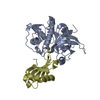
| ||||||||
| 2 | 
| ||||||||
| 3 | 
| ||||||||
| Unit cell |
|
- Components
Components
| #1: Protein | Mass: 24208.754 Da / Num. of mol.: 3 / Mutation: T110A,N179D Source method: isolated from a genetically manipulated source Source: (gene. exp.)  Homo sapiens (human) / Plasmid: pPIC9 / Production host: Homo sapiens (human) / Plasmid: pPIC9 / Production host:  Pichia Pastoris (fungus) / Strain (production host): GS115 / References: UniProt: P07711, cathepsin L Pichia Pastoris (fungus) / Strain (production host): GS115 / References: UniProt: P07711, cathepsin L#2: Protein | Mass: 11020.464 Da / Num. of mol.: 3 Source method: isolated from a genetically manipulated source Source: (gene. exp.)  Homo sapiens (human) / Plasmid: pET3a / Production host: Homo sapiens (human) / Plasmid: pET3a / Production host:  #3: Water | ChemComp-HOH / | Sequence details | CATHEPSIN L WAS BLOCKED WITH MMTS (METHYL METHANETHIOSULFONATE), LEAVING -S-CH3 ATOMS ON ACTIVE ...CATHEPSIN L WAS BLOCKED WITH MMTS (METHYL METHANETHI | |
|---|
-Experimental details
-Experiment
| Experiment | Method:  X-RAY DIFFRACTION / Number of used crystals: 1 X-RAY DIFFRACTION / Number of used crystals: 1 |
|---|
- Sample preparation
Sample preparation
| Crystal | Density Matthews: 1.99 Å3/Da / Density % sol: 38.31 % |
|---|---|
| Crystal grow | Temperature: 293 K / Method: vapor diffusion, sitting drop / pH: 7 Details: 0.1M Tris-HCl, 16% PEG3000, pH 7.0, VAPOR DIFFUSION, SITTING DROP, temperature 293K |
-Data collection
| Diffraction | Mean temperature: 100 K |
|---|---|
| Diffraction source | Source:  SYNCHROTRON / Site: SYNCHROTRON / Site:  ELETTRA ELETTRA  / Beamline: 5.2R / Wavelength: 1 Å / Beamline: 5.2R / Wavelength: 1 Å |
| Detector | Type: MAR CCD 165 mm / Detector: CCD / Date: Aug 20, 2008 / Details: Collimating and focusing, Pt-coated mirrors |
| Radiation | Monochromator: Double Crystal Si111 or White Beam / Protocol: SINGLE WAVELENGTH / Monochromatic (M) / Laue (L): M / Scattering type: x-ray |
| Radiation wavelength | Wavelength: 1 Å / Relative weight: 1 |
| Reflection | Resolution: 1.69→50 Å / Num. all: 90358 / Num. obs: 86021 / % possible obs: 95.2 % / Observed criterion σ(F): 1 / Observed criterion σ(I): 1 / Redundancy: 2 % / Rmerge(I) obs: 0.04 / Net I/σ(I): 13.3 |
| Reflection shell | Resolution: 1.69→1.72 Å / Redundancy: 1.3 % / Rmerge(I) obs: 0.273 / Num. unique all: 2830 / % possible all: 62.7 |
- Processing
Processing
| Software |
| |||||||||||||||||||||||||
|---|---|---|---|---|---|---|---|---|---|---|---|---|---|---|---|---|---|---|---|---|---|---|---|---|---|---|
| Refinement | Method to determine structure:  MOLECULAR REPLACEMENT MOLECULAR REPLACEMENTStarting model: 3KFQ, 1ICF Resolution: 1.71→15.33 Å / Cross valid method: THROUGHOUT / σ(F): 0 / Stereochemistry target values: MAXIMUM LIKELIHOOD Details: HYDROGENS HAVE BEEN ADDED IN THE RIDING POSITIONS U VALUES: REFINED INDIVIDUALLY
| |||||||||||||||||||||||||
| Displacement parameters | Biso mean: 18.15 Å2
| |||||||||||||||||||||||||
| Refinement step | Cycle: LAST / Resolution: 1.71→15.33 Å
| |||||||||||||||||||||||||
| Refine LS restraints |
| |||||||||||||||||||||||||
| LS refinement shell | Resolution: 1.706→1.75 Å
|
 Movie
Movie Controller
Controller





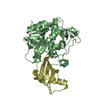
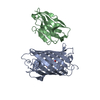
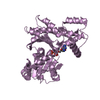
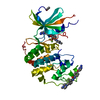
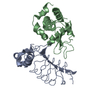
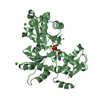
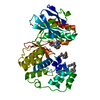
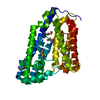
 PDBj
PDBj














